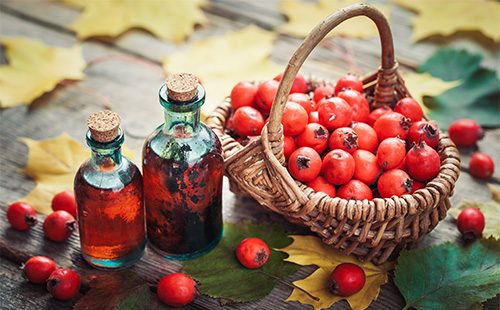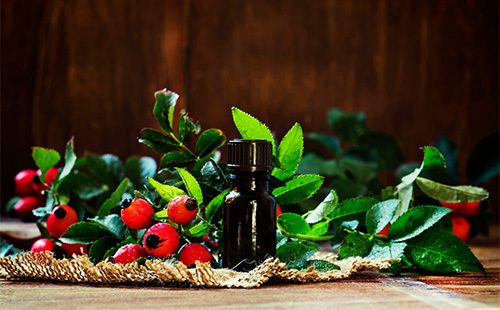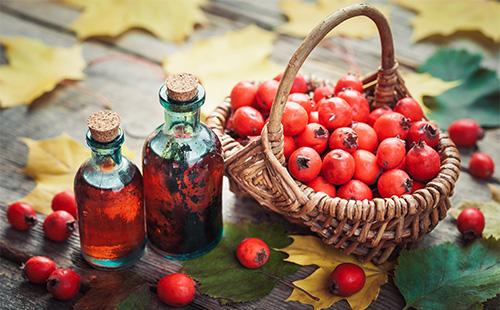The content of the article
Rosehip oil is registered as a medicine and belongs to the group of regenerating drugs. This determines the main action of the squeeze - healing. However, the instructions for use indicate the possibility of using the drug inside for some pathological conditions. At the same time, on the shelves of pharmacies you can find a purely cosmetic product that is not intended for oral administration. It is preferable to give preference to the drug, regardless of the purpose for which the squeeze is acquired.
Composition and properties
The product is obtained by processing the seeds of May hips. Squeeze can be extracted by hot extraction or cold pressing. Cold pressing allows you to save more useful substances in the extraction. Such an oil contains all the healing components that nature has endowed with plant seeds.
The composition of the seeds includes organic acids, saturated and unsaturated fatty acids, flavonoids, tannins, pectins, amino acids. Fat-soluble vitamins (A, E, K, D), as well as B vitamins, ascorbic and nicotinic acids. Salts of minerals - calcium, potassium, phosphorus, zinc, manganese, magnesium, molybdenum, pass from the seeds to the squeeze. A small amount of the volatile compounds that make up the rose ester is also found.
The chemical composition determines the range of pharmacological properties of the squeeze:
- wound healing;
- anti-inflammatory;
- secretory;
- choleretic;
- emollient;
- enveloping;
- immunostimulating;
- fortifying;
- hemostatic.
Diseases for which it helps
With external use, the wound healing properties of the drug are fully manifested. It is used to treat small and shallow skin lesions. Apply to scratches, abrasions, thermal and sunburn, frostbite. Squeeze is useful for inflammatory lesions of the epidermis. The tool is used in the complex therapy of dermatitis, eczema, psoriasis, pathological dry skin, with cracks.
Wild rose seed extract exhibits bacteriostatic activity. It is used for long non-healing wounds with possible violations of the trophism of the epidermis or the attachment of a bacterial infection - with bedsores, trophic ulcers. Effectiveness in the treatment of skin lesions of radiation origin was noted.
The tool treats inflammatory lesions of the mucous membranes - the nose, ears, and oral cavity. Processing is carried out at:
- rhinitis;
- otitis media;
- stomatitis;
- gloss
- periodontal disease;
- tonsillitis;
- pharyngitis;
- sinusitis;
- inflammation of the adenoids;
- injuries of the mucous membranes.
The product gives good results in the treatment of stretch marks and scars. It makes the scars soft, less pigmented, evens out the skin texture. Use on fresh scars can lead to their complete elimination. Old oil scars make less visible.
Squeeze is used externally for female pathologies - for healing of cervical erosion, treatment of nipple cracks.

Indications for oral administration
It is permissible to use a phytopreparation as a vitamin, general strengthening and immunostimulating agent. Doctors recommend it during the recovery period after illness, exhaustion, after serious surgery. It exhibits a mild sedative effect, normalizes the production of hormones and enzymes, improves metabolic processes, lowers blood cholesterol and exhibits an antisclerotic effect. Also regulates blood coagulation. It can be used to eliminate and prevent nasal and internal bleeding.
Rosehip oil is used in the treatment of inflammation and erosive damage to the digestive system:
- chronic hypoacid gastritis;
- stomach ulcers;
- ulcerative colitis;
- bowel damage after radiation therapy;
- proctitis and hemorrhoids.
Squeeze ingestion is prescribed for a decrease in liver and gall bladder function. The tool exhibits a mild choleretic effect, stimulates the secretion of the pancreas, optimizing digestion.
Importance in Cosmetology
The product is saturated with vitamins and other useful substances, therefore it is actively used in cosmetology to improve the condition of the skin of the whole body. The tool is used in its pure form for intensive care of dry dermis, added to cosmetics to enrich the composition. Squeezing wild rose seeds is useful for the following effects:
- eliminates defects (scars, pigmentation, seals);
- removes and prevents wrinkles;
- suitable for skin around the eyes and neck;
- tones up;
- improves complexion;
- eliminates circles under the eyes;
- nourishes;
- intensively moisturizes;
- promotes hair growth;
- treats dandruff caused by dry head;
- promotes eyelash growth.
The tool is used to treat stretch marks and scars on the body - do massages and body wraps. Due to the anti-inflammatory properties, the drug eliminates peeling, redness. It softens the skin, promotes moisture retention in its structure.
Therapy Rules
In order for the product to fully demonstrate its healing qualities, you should learn how to use it wisely. The use for medicinal purposes inside, with dermatological and cosmetic problems, occurs according to different rules.
Oral use
The drug is drunk a teaspoon twice a day before meals. Such a scheme is used both for treatment and for prevention. The maximum duration of the course is a month. With a deviation from the recommended period to a greater or lesser extent, withdrawal syndrome is possible.
Treatment of the skin and mucous membranes
Therapy of dermatological problems requires topical application of herbal medicine. But often, doctors recommend using the drug both externally and inward. This provides a cleansing of the body and additional intake of vitamins.
- Treatment of the mucous membranes. With rhinitis, it is recommended to instill oil in the nose up to three times a day, with sinusitis - up to six times. When otitis media, they are placed turunds soaked in the drug.If the mucous membranes of the mouth are affected, they are treated by wetting a piece of gauze in the product. You can also rinse the problem areas by typing a tablespoon of the medicine. It is impossible to swallow the drug after treatment.
- Skin treatment. For cracks, dryness, trophic ulcers and pressure sores, compresses are applied up to three times a day. Gauze is impregnated with a tool, applied to the affected area, covered with wax paper and fixed with a free bandage. With minor damage - just lubricate the skin with a cotton swab. If the skin is dry due to eczema or psoriasis, 10 ml of squeezed rose is mixed with five drops of ether lavender. Make compresses with the mixture.

For beauty
To preserve the beauty and improve the condition of the skin, the product is used as follows:
- body - carry out massages, apply to dry and hard areas of the skin to soften them;
- face - applied in pure form for a quarter of an hour, add a couple of drops to a daily portion of the cream, injected into the composition of the masks instead of another oily component, mixed with coffee grounds to obtain a nourishing scrub;
- hair - add to shampoos and balms (10 g per 100 g of base), rubbed into the roots an hour before washing;
- eyelashes and lips - Apply to the eyelashes with a brush, make lip compresses, soaking in small pieces of a napkin.
Squeezed roses can be added to all flushed cosmetic products. This will increase their nutritional value, provide antioxidant and anti-aging properties.
Squeezing rosehip seeds can stimulate metabolic processes, improve digestion, help the absorption of nutrients from food, eliminate fluid retention in the body. The tool is often used for weight loss: it is useful as a source of vitamins and minerals, but does not significantly affect the weight.

